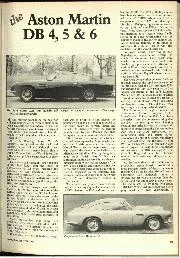
The Aston Martin DB 4, 5 & 6
Aston Martins seem to be the post-war embodiment of the vintage Bentley in being big, beefy and thoroughly British. Not for this company the mid-engined design of their exotic Continental…
Motor racing’s governing body, the FIA, wants to bring back an innovation of the 1970s as part of its plan to improve grand prix racing when new rules come into effect from 2021.
The FIA’s plans involve simplified aerodynamics, a move away from high-degradation tyres – which current supplier Pirelli was asked to provide when it came back to F1 in 2011 – and a return to the ground-effect principle introduced by Colin Chapman’s Team Lotus in the late 1970s.
The FIA’s single-seater technology chief Nikolas Tombazis, formerly a senior F1 aerodynamicist for Benetton, Ferrari and McLaren, said: “We want to make it possible for cars to race and follow each other and to have more exciting battles. We want drivers to be able to fight each other without tyres degrading.”
According to the latest proposals, 2021 designs will be stripped of many of the intricate aero details whose effectiveness is compromised when running in the turbulent air of a car just ahead.
“We want drivers to fight each other without tyres degrading”
“They will be simpler than the current cars because a lot of the small components have been removed, especially in front of the sidepods,” Tombazis said. “The front wings are simpler and there are venturi tunnels under the sidepods from the front to the back.”
The Lotus 78 was the first ground-effect car to have a serious impact on F1, in 1977, and Mario Andretti took the following season’s world title in the dominant Lotus 79. The concept was subsequently embraced and fine-tuned by constructors such as Williams and Brabham, before it was banned ahead of the 1983 season to counter fears about the rapidly escalating cornering speeds of the cars.
Full details of the 2021 regs are expected to be unveiled in October.